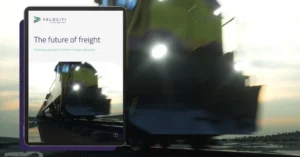Rail freight is something of an unsung hero, and its growth is key to supporting a more sustainable transport network.
When you consider that a single freight train can take up to 76 lorries off the nation’s roads, that’s pretty heroic. But it’s not just the country’s motorists who would welcome the impact of rail freight on our congested roads.
There’s the compelling environmental case too.
Rail freight saves over one million tonnes of carbon every year, according to Network Rail. Statistics like these suggest that boosting the rail freight industry is becoming increasingly urgent if the country is to meet its net zero targets.
In fact, rail freight plays a more important role in the country’s economy than many realise.
Each time we buy something from a supermarket, or order from an online retailer, those products are likely to have made part of their journey by rail. Yet it’s not something most people think about when they tap through their payment or open a parcel.
A need for rail freight growth
Fortunately, there is growing recognition from policymakers that we need to shift more freight away from roads and towards the railway.
Along with the rail freight growth targets set by the Office of Rail and Road, additional initiatives are aimed at driving growth in the sector.
The Mode Shift Revenue Support (MSRS) scheme for rail and inland water freight has been extended by a year, helping with the cost of moving goods by rail. Similarly, Network Rail’s discounts on track access charges are designed to support the growth of rail freight.
The tide may be turning for rail freight, but real change will only happen when the industry gains a clearer view of how freight paths are used.
The freight path challenge
If you take a look at the rail timetable, it appears there’s not much capacity on the network to run additional freight trains. This obviously makes it challenging to grow rail freight, meet government targets and cut CO2 emissions.
However, due to the complexity and unpredictability of supply and demand, some of those timetabled freight paths are booked but not used. This means there is spare capacity on the network, but it remains hidden from sight.
Unlocking these hidden freight paths is possible, but it’s always been a very time-consuming, process. Teams of skilled people regularly spend a whole fortnight manually extracting all the data on freight paths and going through them line-by-line to see which paths ran and which did not, and therefore which are likely to be available.
A clearer view of freight path utilisation
To gain a more accurate picture of freight path capacity, the data needs to be much easier to access, analyse and review, and this is what Velociti Solutions has been working to achieve with its PathPlanner data.
By pulling the data together into a web interface, Velociti is enabling the freight capacity team at Network Rail to log on and to see the percentage of paths which are booked, and the proportion of those which are actually being used.
This allows Network Rail to see if there is existing capacity on the network to run additional freight trains, while protecting the capacity for freight use and supporting operators in their ability to run services as required by customers.
Unlocking insight from this data will help to identify genuine capacity on the network, while still allowing freight operators the essential flexibility they need to meet the complex demands of their customers.
Using data in this way promises to be a gamechanger in strategic freight planning, helping the country meet its rail freight growth targets.
Reduced disruption on the rail network
Another challenge for the rail freight industry is the unavoidable disruption caused by engineering and maintenance work on the railway.
To allow essential repair work to happen, Network Rail’s access planning team has to cancel trains, or set emergency speed restrictions. While the team aims to identify the quietest times to carry out work, it can still have a negative impact on rail freight, putting businesses off choosing rail to move their goods.
If teams have more accurate data on which paths are going to be used, they can schedule engineering work at a time which causes the least possible disruption. They can also avoid postponing repairs at a time when the network looks busy, when in reality, no trains are planned to run.
Velociti is currently setting up a pilot with Network Rail’s access planners, so they can see how insight from PathPlanner can help to keep rail services running smoothly while maintaining rail infrastructure.
We’re looking forward to seeing the impact of the pilot, and exploring the wider benefits for the rail sector of having a clearer picture of what’s happening on the network.
Better access to freight path data will make rail freight the superhero of UK industry, by removing HGVs from the roads, keeping the wheels of commerce turning and supporting the business community.


